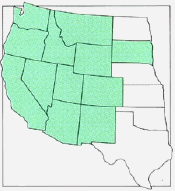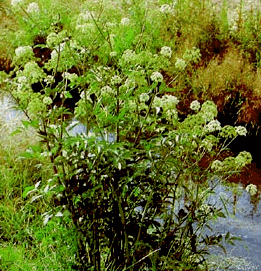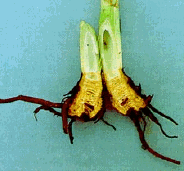| Water hemlock (Cicuta douglasii) |

|
Water hemlock has small, white flowers that grow in umbrella like clusters. Side veins of the leaves lead to notches, not to tips at the outer margin. The thick rootstalk of water hemlock contains a number of small chambers. These hold a highly poisonous brown or straw-colored liquid that is released when the stem is broken or cut. Thick, fleshy tubers and slender individual roots grow from the bottom of the rootstalk. Water hemlock grows in wet seepage areas of meadows, pastures, and in streams. It reaches a height of 0.5 to 1.0 meters. The plant is a perennial in the carrot family. Water hemlock may be confused with poison-hemlock because of the similarity in names; however, these two are different plants that cause different types of poisoning. It has also been confused with wild parsnips, other herbs, and medicinal plants. In cases of water hemlock poisoning in humans, contact a poison control center and obtain emergency medical assistance as quickly as possible. Poisoning results in severe seizures and convulsions that must be controlled to preserve normal ventilation and cardiovascular function.
Animals will eat water hemlock early in spring and graze on the green seed heads later in the season. The roots; however, are more palatable and animals have been poisoned when the roots are exposed by plowing or cleaning ditches or when animal tramp in the streambeds. The underground portions of the plant, especially the tuberous roots, are highly toxic and very dangerous. Green seed heads have caused death losses in cattle. The toxic substance in water hemlock is cicutoxin, a highly poisonous unsaturated alcohol that has a strong carrot-like odor. It is found principally in the tubers, but is also present in the leaves and stems during early growth. Leaves and stems lose most of their toxicity as they mature; however, green seed heads are poisonous.  Where and When It Grows How It Affects Livestock Signs and Lesions of Poisoning How to Reduce Losses To reduce losses, keep animals away from places where water hemlock grows. The stems and leaves of water hemlock increase in palatability immediately after being sprayed with herbicide. Therefore, keep animals away from treated plants for 3 weeks after spraying. Most losses occur early in the spring or after the plants have been sprayed with 2,4-D. The plants, which usually grow in small patches, are easy to locate. Spraying or grubbing can eradicate them. Actively growing plants can be controlled with 2,4-D applied at the rate of 1 kg per acre of acid equivalent. Repeat spray treatments until eradication is completed. Follow all precautions for handling herbicides. If you grub water hemlock, be sure to get all of the plant, including roots. Gather and burn every part. |

 Water hemlock is the most violently toxic plant that grows in North America. Only a small amount of the toxic substance in the plant is needed to produce poisoning in livestock or in humans. The toxin cicutoxin, acting directly on the central nervous system, is a violent convulsant. Clinical signs of poisoning occur when a threshold dose is reached after which grand mal seizures and death occur.
Water hemlock is the most violently toxic plant that grows in North America. Only a small amount of the toxic substance in the plant is needed to produce poisoning in livestock or in humans. The toxin cicutoxin, acting directly on the central nervous system, is a violent convulsant. Clinical signs of poisoning occur when a threshold dose is reached after which grand mal seizures and death occur.
